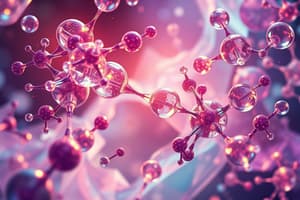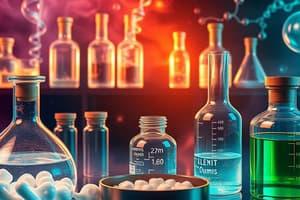Podcast
Questions and Answers
What plant was used by the American Indians for its medicinal properties?
What plant was used by the American Indians for its medicinal properties?
- Coca Leaves
- Ipecacuanha Root
- Chaulmoogra Fruit (correct)
- Opium
Which of these accurately describes the 19th Century in terms of medicinal chemistry?
Which of these accurately describes the 19th Century in terms of medicinal chemistry?
- The use of plants in medicine was abandoned in favor of synthesized chemical compounds.
- The importance of chemistry in understanding drug mechanisms was completely disregarded.
- The invention of microscopes allowed for the discovery of the active compounds within plants.
- The focus shifted from finding new medicaments from plants, to understanding the active ingredients that caused their effects. (correct)
During the Middle Ages, what substance did Paracelsus believe had cure-all properties?
During the Middle Ages, what substance did Paracelsus believe had cure-all properties?
- Morphine
- Sodium Chloride (NaCl)
- Aspirin
- Antimony (Sb) (correct)
Which of these is NOT a historical example of a drug used in antiquity?
Which of these is NOT a historical example of a drug used in antiquity?
Which of these is the earliest recorded example of a drug used in history?
Which of these is the earliest recorded example of a drug used in history?
Which of the following drugs was discovered in the 19th century?
Which of the following drugs was discovered in the 19th century?
What was the first mass-produced synthetic drug?
What was the first mass-produced synthetic drug?
Which of the following is NOT a synthetic drug?
Which of the following is NOT a synthetic drug?
Which of the following scientists discovered penicillin?
Which of the following scientists discovered penicillin?
Which of the following is a type of antidepressant?
Which of the following is a type of antidepressant?
Which of the following drugs was discovered during the Middle Ages?
Which of the following drugs was discovered during the Middle Ages?
What is the primary function of an SSRI drug?
What is the primary function of an SSRI drug?
Which of the following drugs was discovered in the early 20th century?
Which of the following drugs was discovered in the early 20th century?
Which of these drugs were not discovered in the 19th century?
Which of these drugs were not discovered in the 19th century?
Which discovery or event paved the way for anticholesterol drugs?
Which discovery or event paved the way for anticholesterol drugs?
Which of the following scientists discovered oxytocin?
Which of the following scientists discovered oxytocin?
Which of the following is NOT a steroid?
Which of the following is NOT a steroid?
Which of the following drugs is NOT a structural analogue of cocaine?
Which of the following drugs is NOT a structural analogue of cocaine?
Which of the following drugs was discovered in 1963?
Which of the following drugs was discovered in 1963?
Which of the following drugs is an emergency contraceptive?
Which of the following drugs is an emergency contraceptive?
Which of the following drugs is an inorganic drug?
Which of the following drugs is an inorganic drug?
Flashcards
Medicinal Chemistry
Medicinal Chemistry
The study of chemical compounds for therapeutic use in medicine.
Quantitative Structure-Activity Relationship
Quantitative Structure-Activity Relationship
A method to predict the effects of molecular structures on biological activity.
Morphine Extraction
Morphine Extraction
Morphine was first extracted from poppy by Serturner in 1805, revealing its properties.
Paracelsus
Paracelsus
Signup and view all the flashcards
Chaulmoogra Fruit
Chaulmoogra Fruit
Signup and view all the flashcards
Laudanum
Laudanum
Signup and view all the flashcards
Phenobarbital
Phenobarbital
Signup and view all the flashcards
Cocaine
Cocaine
Signup and view all the flashcards
Digitalis purpurea
Digitalis purpurea
Signup and view all the flashcards
Compactin (Mevastatin)
Compactin (Mevastatin)
Signup and view all the flashcards
6-mercaptopurine
6-mercaptopurine
Signup and view all the flashcards
Cisplatin
Cisplatin
Signup and view all the flashcards
Organic Pharmaceutical Chemistry
Organic Pharmaceutical Chemistry
Signup and view all the flashcards
Emetine
Emetine
Signup and view all the flashcards
Quinine sulfate
Quinine sulfate
Signup and view all the flashcards
Acetic Acid
Acetic Acid
Signup and view all the flashcards
Side Chain Theory
Side Chain Theory
Signup and view all the flashcards
Aspirin
Aspirin
Signup and view all the flashcards
Penicillin
Penicillin
Signup and view all the flashcards
Chlorpromazine
Chlorpromazine
Signup and view all the flashcards
Insulin
Insulin
Signup and view all the flashcards
Norethindrone
Norethindrone
Signup and view all the flashcards
Mifepristone
Mifepristone
Signup and view all the flashcards
Study Notes
Introduction to Medicinal Chemistry
- This presentation covers the history and evolution of medicinal chemistry.
- It defines organic pharmaceutical chemistry.
- It outlines the quantitative relationship between structure and activity.
- It details the functional groups involved in organic chemistry.
Drugs of Antiquity
- Shen Nung (2735 BC) is associated with early medicinal use of plants, including Ch'ang shang and Ma huang.
- American Indians used Chaulmoogra fruit, Ipecacuanha root, and Coca leaves.
- The Greek Apothecary used opium, squill, hyoscyamus, viper toxin, metal ores (Cu, Zn, Fe sulfate, Cadmium oxide).
Middle Ages
- Chemistry and physics shifted from Greco-Roman to Arabian alchemists.
- Paracelsus believed in using chemicals (Sb) as cures.
19th Century: Age of Innovation and Chemistry
- Medicine progressed from plant-derived drugs to the identification of active compounds within plants.
- 1805 - Morphine extraction from poppies by Serturner.
- 1810 - Hahnemann introduces homeopathy, a theory differing from Galen's approach.
- 1816 - Emetine isolation from Ipecacuanha by Pierre-Pelletier.
- 1820 - Caffeine, quinine, and colchicine purification.
- 1826 - Mass production of quinine.
- 1845 - Adolph Kolbe synthesizes Acetic Acid.
- 1878 - John Langley proposes a biological receptor model.
- 1886 - Coniine, an alkaloid from hemlock, synthesis.
- 1897 - Ehrlich describes the Side Chain Theory, linking molecular structure with function.
- 1898 - Bayer produces the synthetic drug Aspirin in mass quantities.
20th Century and Pharmaceutical Industry
- Synthetic chemotherapeutic agents emerge.
- 1929 - Fleming discovers penicillin.
- 1940 - Sulfonamide-like drugs display bacteriostatic action.
- 1973 - Akira Endo discovers the cholesterol-lowering drug Compactin.
- 1978 - Merck discovers a substance identical to Endo's, naming it Lovastatin.
- Later development of statins like Atorvastatin (Lipitor).
Psychopharmacologic Agents and Era of Brain Research
- Chlorpromazine and Imipramine are significant psychiatric breakthroughs.
- Iproniazid's antidepressant effects.
- 1970s development of Tricyclic antidepressants and later of SSRI.
- Development of benzodiazepines.
Endocrine Therapy and Steroid
- Epinephrine's discovery as a pure hormone.
- 1904 - Oxytocin discovery.
- 1914 - Thyroxine isolation.
- 1921 - Banting and Best discover insulin.
- Development of genetically engineered insulins (Humulin).
- Symlin(2005) and inhaled insulin (2006) for Type 1 diabetes.
- 1930 - Diosgenin to Progesterone Conversion.
- Norethindrone(1950), Progesterone(1956).
- Mifepristone(1980); Misoprostol and morning-after pill development(1994).
Anesthetics and Analgesics
- Historic development, from nitrous oxide to ether and chloroform, as anesthetics.
- Horace Wells, Crawford Long, and William Morton
- Early development of anesthetic use in medicine.
Hypnotics and Anticonvulsants
- Laudanum and other early sleep-inducing drugs.
- 1864 - Von Beyer synthesizes barbituric acid.
- Bayer introduce Phenobarbital (Luminal).
- Development and use of Hydantoins (Phenytoin-Dilantin).
Local Anesthetics
- Cocaine's isolation (1860) and use in medicine.
- 1897- Carl Koller's use for topical anesthesia.
- Development of related compounds (Benzocaine, procaine, tetracaine, and lidocaine).
Drugs Affecting Renal and Cardiovascular Function
- Digitalis purpurea's discovery of its beneficial effects (1775).
- 1841 - Digitoxin isolation.
- 1929 - Digoxin isolation.
- 1970s development of cholesterol-lowering drugs.
Antineoplastic Agents
- Sulfur mustards and nitrogen mustards and their initial use against leukemia.
- 1893 - Cisplatin discovery.
- 1963 - Paclitaxel (Taxol) discovery.
- Carboplatin developed later as a second generation drug.
Organic Pharmaceutical Chemistry
- Focuses on developing carbon-based medicinals.
- Combines chemistry and pharmacy.
- Involves drug design, synthesis, and development.
- Identifies, synthesizes, and develops chemical entities for therapeutic use.
- Focuses on quality assurance in medicines.
Quantitative Structure-Activity Relationship (QSAR)
- Strategy to understand how changing a molecule's structure affects biological activity.
- Predicts activity changes based on structural modifications.
Functional Groups in Organic Chemistry
- Detailed classification of functional groups and their roles in organic chemistry
- Key examples of different functional groups, naming conventions, and structural representations.
Hydrocarbons
- Classification of hydrocarbons.
- Aliphatic hydrocarbons, including saturated (alkanes), unsaturated (alkenes and alkynes)
- Cyclic hydrocarbons, including alicyclic and aromatic hydrocarbons.
Benzene Derivatives
- Classification and naming conventions of benzene derivatives.
- Examples of different benzene functional groups.
Required Readings
- Students are required to review a webpage on the history of medicinal chemistry.
- A quiz is scheduled in the next session.
Studying That Suits You
Use AI to generate personalized quizzes and flashcards to suit your learning preferences.




